- Crowns & Bridges
- Veneers
- Dentures
- Removable Partial Denture
- Fixed Partial Denture
- Complete Denture
- Immediate Denture
- Overdenture
- Flexible Denture
- Tissue Conditioning / Soft Relining
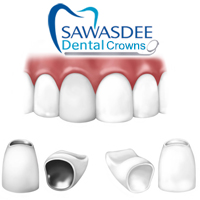
A crown is a type of dental restoration which completely caps or encircles a tooth or dental implant. They are typically bonded to the tooth using a dental cement. Crowns are often used to improve the strength or appearance of teeth.
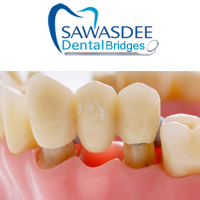
A bridge is a fixed dental restoration used to replace a missing tooth by joining an artificial tooth permanently to adjacent teeth or dental.
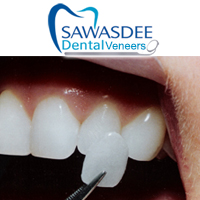
A veneer is a thin layer of material placed over a tooth, either to improve the aesthetics of a tooth or to protect tooth's surface from damage. There are two main types of material used to fabricate a veneer: composite and dental porcelain. A composite veneer may be directly placed (built-up in the mouth), or indirectly fabricated by a dental technician in a dental laboratory, and later bonded to the tooth, a porcelain veneer may only be indirectly fabricated.
Dentures :-
Dentures, also known as false teeth, are prosthetic devices constructed to replace missing teeth, and which are supported by surrounding soft and hard tissues of the oral cavity. Conventional dentures are removable, however there are many different denture designs, some which rely on bonding or clasping onto teeth or dental implants.
Removable partial dentures :-
These are for patients who are missing some of their teeth on a particular arch.
Fixed partial dentures :-
It is also known as "crown and bridge", are made from crowns that are fitted on the remaining teeth to act as abutments and pontics made from materials to resemble the missing teeth. Fixed bridges are more expensive than removable appliances but are more stable.
Complete dentures :-
Conversely, complete dentures or full dentures are worn by patients who are missing all of the teeth in a single arch (i.e. (upper) or mandibular (lower) arch).
Immediate denture :-
An immediate denture is what it says. It is placed immediately after the teeth have been extracted. It cannot and will not function or feel like a denture placed over healed oral tissue. It does provide a certain amount of function and estheticizes for the patient.
Approximately 6 months after receiving your immediate dentures, the dentures will have to be re-based, relined or a new denture will have to be made.
As a note, there is no such thing as a "permanent denture" as your mouth will continue to change shape over time. Well-made dentures can last you 5 to 10 years, but they may need to be adjusted or re-made depending on the healing process.
Overdenture :-
A complete or partial removable denture supported by retained roots that is intended to provide improved support, stability, and tactile and proprioceptive sensation and to reduce ridge resorption.
Flexible Denture :-
We also offer the option of flexible val-plast dentures to our patients. Since these are flexible, they offer greater patient compliance and are more comfortable than regular partial dentures. These are also more enthetic as the unesthetic ally visible metal clasps are no longer needed.
Tissue Conditioning / Soft Relining :-
Relines
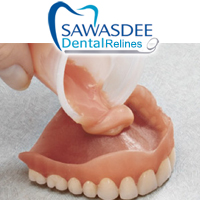 Complete or partial denture bases are made of hard acrylic-plastic-resin. The bone and soft tissues underneath a denture respond to the pressure of use by resorbing. These hard denture materials retain their relative shape over time, but the underlying tissues do not. These dentures rest on the soft tissue which over time will eventually change (both the soft external tissue and bone underneath) and then the prosthesis will require either a replacement prosthesis or a reline of the hard material in the space created by that change. There are many types of relines and their purposes, as well as their method of application, are different depending on the reason they are used.
Complete or partial denture bases are made of hard acrylic-plastic-resin. The bone and soft tissues underneath a denture respond to the pressure of use by resorbing. These hard denture materials retain their relative shape over time, but the underlying tissues do not. These dentures rest on the soft tissue which over time will eventually change (both the soft external tissue and bone underneath) and then the prosthesis will require either a replacement prosthesis or a reline of the hard material in the space created by that change. There are many types of relines and their purposes, as well as their method of application, are different depending on the reason they are used.
Tissue Conditioner:-
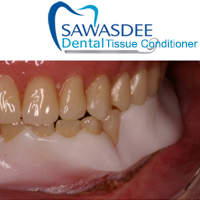 This is a soft reline material that is used to facilitate healing of the tissue under a prosthesis, like a complete or removable partial denture. These are used for many reasons, which include:
This is a soft reline material that is used to facilitate healing of the tissue under a prosthesis, like a complete or removable partial denture. These are used for many reasons, which include:
- immediate dentures
- acting as a bandage while healing from surgery
- temporary relief of a ill fitting prosthesis
- sore tissue relief
- temporary treatment of denture bearing tissue before a new prosthesis is fabricated
- temporary space filling in the denture while implants and tissues heal
- concomitant treatment for candida infection.
This material is very soft and comforting to the tissue. It is initially very soft and then gradually loses this softness and becomes harder with time. This helps condition the tissue and assists in healing. Due to the nature of the material it is intended for short term use, typically 1 to 2 weeks, but up to 3 weeks in some cases. Since it cannot be brushed and cleaned like a typical hard denture base it will collect more bacteria and fungi as time goes on and must be replaced.






